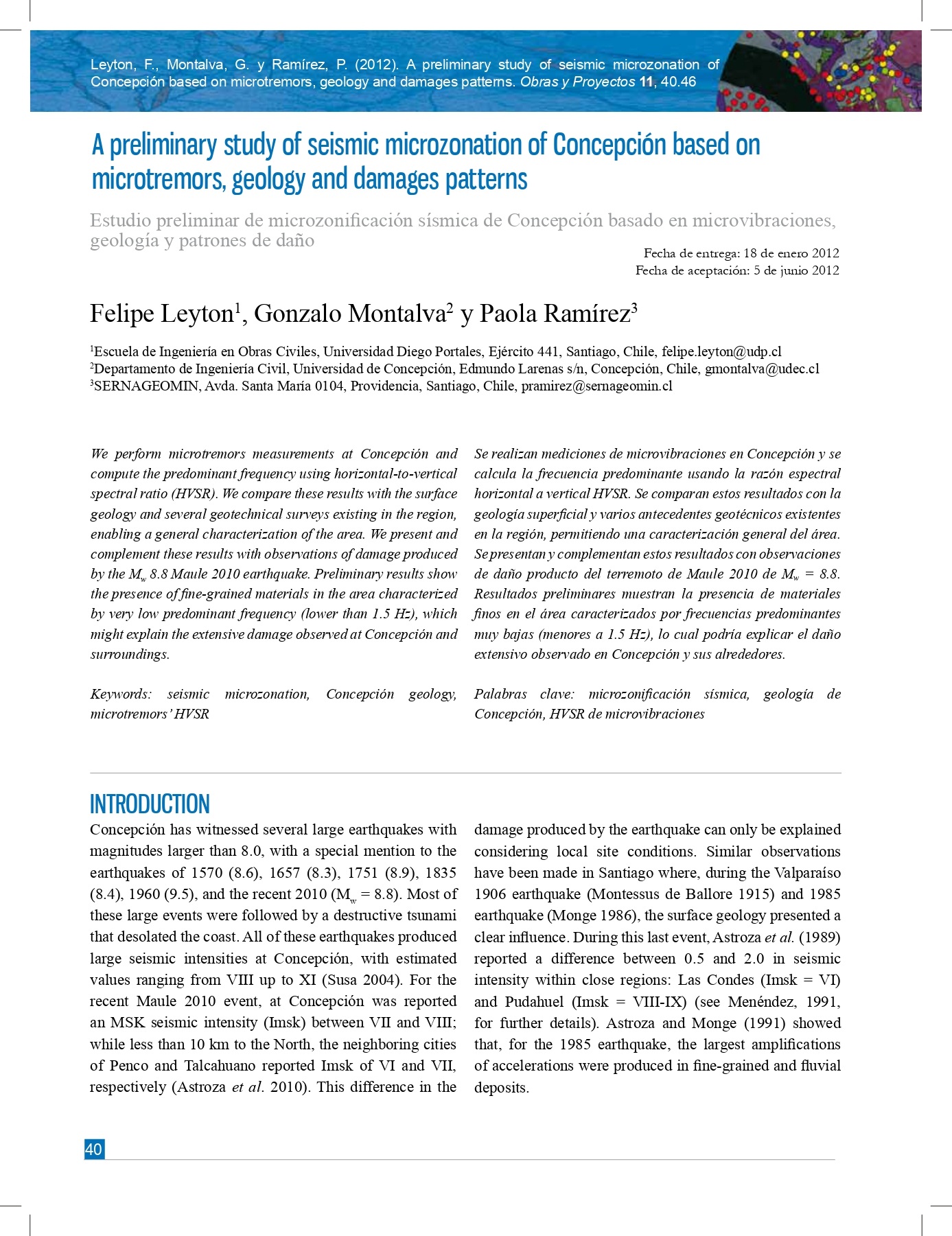Estudio preliminar de microzonificación sísmica de Concepción basado en microvibraciones, geología y patrones de daño
DOI:
https://doi.org/10.4067/S0718-28132012000100004Palabras clave:
microzonificación sísmica, geología de Concepción, HVSR de microvibracionesResumen
Se realizan mediciones de microvibraciones en Concepción y se calcula la frecuencia predominante usando la razón espectral horizontal a vertical HVSR. Se comparan estos resultados con la geología superficial y varios antecedentes geotécnicos existentes en la región, permitiendo una caracterización general del área. Se presentan y complementan estos resultados con observaciones de daño producto del terremoto de Maule 2010 de Mw = 8.8. Resultados preliminares muestran la presencia de materiales finos en el área caracterizados por frecuencias predominantes muy bajas (menores a 1.5 Hz), lo cual podría explicar el daño extensivo observado en Concepción y sus alrededores.
Referencias
Astroza, M. and Monge, J. (1991). Seismic microzones in the city of Santiago. Relating damage-geological unit. Proc 4th International Conference on Seismic Zonation, Stanford, California, August, Vol. III, 595-601.
Astroza, M., Monge, J. y Varela, J. (1989). Zonificación sísmica de la Región Metropolitana. 5as. Jornadas Chilenas de Sismología e Ingeniería Antisísmica, Vol. 1, Santiago, Chile.
Astroza, M., Cabezas, F., Moroni, M.O., Massone, L., Ruiz, S., Parra, E., Cordero, F. y Mottadelli, S. (2010). Intensidades sísmicas en el área de daños del terremoto del 27 de febrero de 2010. Departamento de Ingeniería Civil, Facultad de Ciencias Físicas y Matemáticas; Universidad de Chile, Santiago, Chile.
Bard, P.Y. (1998). Microtremors measurements: a tool for site effect estimation?. Proceeding of the Second International Symposium on the Effects of Surface Geology on Seismic Motion, Yokohama, Japan, 3, 1251-1279.
Bard, P.Y. and SESAME-Team (2005). Guidelines for the implementation for the H/V spectral ratio technique on ambient vibrations-measurements, processing and interpretations. In SESAME European research project EVG1-CT-2000-00026, available at http://sesame-fp5.obs.ujf-grenoble.fr
Betanzo, R. (2010). Daños estructurales y lecciones del terremoto del 27/f en el Gran Concepción. Obras y Proyectos 8, 59-75.
Bonnefoy-Claudet, S., Cornou, C., Bard, P.Y., Cotton, F., Moczo, P., Kristek, J. and Fâh, D. (2006a). H/V ratio: a tool for site effects evaluation. Results from 1-D noise simulations. Geophysical Journal International 167, 827-837. https://doi.org/10.1111/j.1365-246X.2006.03154.x
Bonnefoy-Claudet, S., Cornou, C. and Bard, P.Y. (2006b). The nature of noise wavefield and its application for sites studies: A literature review. Earth-Science Reviews 79(3-4), 205-227. https://doi.org/10.1016/j.earscirev.2006.07.004
Bonnefoy-Claudet, S., Kohler, A., Cornou, C., Wathelet, M. and Bard, P. Y. (2008). Effects of Love waves on microtremor H/V ratio. Bulletin of the Seismological Society of America 98(1), 288-300. https://doi.org/10.1785/0120070063
Bonnefoy-Claudet, S., Baize, S., Bonilla, L.F., Berge-Thierry, C., Pasten, C., Campos, J., Volant, P. and Verdugo, R. (2009). Site effect evaluation in the basin of Santiago de Chile using ambient noise measurements. Geophysical Journal International 176(3), 925-937. https://doi.org/10.1111/j.1365-246X.2008.04020.x
Chávez-García, F.J., Dominguez, T., Rodriguez, M. and Pérez, F. (2007). Site effects in a volcanic environment: a comparison between HVSR and array techniques at Colima, Mexico. Bulletin of the Seismological Society of America 97, 591-604. https://doi.org/10.1785/0120060095
Field, E.H. and Jacob K.H. (1995). A comparison and test of various site-response estimation techniques, including three that are not reference-site dependent. Bulletin of the Seismological Society of America 84(4), 1127-1143.
Galli, C. (1967). Geología urbana y suelos de fundación de Concepción y Talcahuano. Informe final del proyecto de investigación No 75, Comisión de Investigación Científica de la Universidad de Concepción, Concepción, Chile.
Gajardo, A. (1981). Hoja Concepción-Chillán, región del Bío-Bío, 1:250.000. Mapas geológicos preliminares de Chile, Instituto de Investigaciones Geológicas.
Inostroza, G. (2004). Metodología de estratificación y zonificación de los suelos de la Comuna de Concepción, mediante la aplicación de SIG. Memoria de Ingeniería Civil. Universidad del Bío-Bío, Concepción.
Kanai, K. (1957). The requisite conditions for predominant vibration of ground. Bulletin of the Earthquake Research Institute, Tokyo University, 35, 457-470.
Konno, K. and Ohmachi, T. (1998). Ground-motion characteristics estimated from spectral ratio between horizontal and vertical components of microtremor. Bulletin of the Seismological Society of America 88(1), 228-241. https://doi.org/10.1785/BSSA0880010228
Lachet, C., Hatzfeld, D., Bard, P.Y., Theodulidis, N., Papaioannou, C. and Savvaidis, A. (1996). Site effects and microzonation in the city of Thessaloniki (Greece) comparison of different approaches. Bulletin of the Seismological Society of America 86(6), 1692-1703. https://doi.org/10.1785/BSSA0860061692
Lermo, J. and Chávez-García F.J. (1993). Site effect evaluation using spectral ratios with only one station. Bulletin of the Seismological Society of America 83, 1574-1594. https://doi.org/10.1785/BSSA0830051574
Leyton, F. and Ruiz, S. (2011). Comparison of the behavior of site from strong motion data of the 1985 Central Chile earthquake (Ms = 7.8) and microtremors measurements. Proceedings of the 5th International Conference on Earthquake Geotechnical Engineering, Santiago, Chile.
Leyton, F., Sepúlveda, S.A., Astroza, M., Rebolledo, S., Acevedo, P., Ruiz, S., Gonzalez, L. and Foncea, C. (2011). Seismic zonation of the Santiago Basin, Chile. Fifth International Conference on Earthquake Geotechnical Engineering, Santiago, Chile.
Menéndez, P. (1991). Atenuación de las intensidades del sismo del 3 de marzo de 1985 en función de la distancia a la zona de ruptura y del tipo de suelo. Memoria de Ingeniero Civil, Universidad de Chile, Santiago.
Monge, J. (1986). El sismo del 3 de marzo de 1985, Chile. CAP, Santiago, Chile.
Montessus de Ballore, F. (1915). Historia Sísmica de los Andes Meridionales al Sur del Paralelo XVI, Quinta Parte. El Terremoto del 16 de Agosto de 1906. Soc. Imprenta-Litografía Barcelona, Santiago, Chile.
Nakamura, Y. (1989). A method for dynamic characteristics estimations of subsurface using microtremors on the ground surface. Q. Rep. Railway Tech. Res. Inst. Japan 30, 25-33.
Nakamura, Y. (1996). Real-time information systems for hazard mitigation. Proceedings of the 10th World Conference in Earthquake Engineering, paper # 2134.
Nakamura, Y. (2000). Clear identification of fundamental idea of Nakamura's technique and its applications. Proc. 12th World Conference on Earthquake Engineering, Auckland, New Zealand.
Nogoshi, M., and Igarashi, T. (1970). On the propagation characteristics of microtremors (part 2). J. Seismol. Soc. Japan 23, 264-280 (in Japanese with English abstract).
Nogoshi, M. and Igarashi, T. (1971). On the amplitude characteristics of microtremors (part 2). J. Seismol. Soc. Japan 24, 26-40 (in Japanese with English abstract).
Ramírez, P. y Vivallos, J. (2009). Microzonificación sísmica de la ciudad de Concepción-Chile. XII Congreso Geológico Chileno, Santiago, Chile, S3-018.
Ramírez, P. y Falcón, F. (2010). Efectos geológicos del sismo del 27 de Febrero de 2010: Calidad de los suelos, gravimetría y respuesta sísmica de los suelos, en relación al catastro de Edificios colapsados y con daños severos en la ciudad de Concepción, Región del Bio-Bío. Informe Técnico Inf-Biobio-25 del Servicio Nacional de Geología y Minería, Santiago, Chile.
Susa, D. (2004). Evaluación del peligro sísmico asociado a sismos de tipo interplaca en Chile y sur del Perú utilizando una distribución bi-paramétrica de Weibull. Memoria de Ingeniero Civil, Universidad de Chile, Santiago.
Tokimatsu, K. (1997). Geotechnical site characterization using surface waves. Proceedings of the 1st International Conference on Earthquake Geotechnical Engineering, Tokyo, Vol. 3, 1333-1368.
Troncoso, J. (1992). Fundamentos de Ingeniería Geotécnica Antisísmica. Ediciones Universidad Católica de Chile, Santiago, Chile.
Udwadia, F.E. and Trifunac, M.D. (1973). Comparison of earthquake and microtremor ground motion in El Centro, California. Bulletin of the Seismological Society of America 63,1227-1253. https://doi.org/10.1785/BSSA0630041227
Verdugo, R., Villalobos, F., Yasuda, S., Konagai, K., Sugano, T., Okamura, M., Tobita, T. and Torres, A. (2010). Description and analysis of geotechnical aspects associated to the large 2010 Chile earthquake. Obras y Proyectos 8, 25-36.
Wessel, P. and Smith, W.H.F. (1991). Free software helps map and display data. EOS Trans. AGU, 72, 441.
Woolery, E.W. and Street, R. (2002). 3D near-surface soil response from H/V ambient-noise ratios. Soil Dynamics and Earthquake Engineering 22(9-12), 865-876. https://doi.org/10.1016/S0267-7261(02)00109-4

Descargas
Publicado
Número
Sección
Licencia
Derechos de autor 2012 Universidad Católica de la Santísima Concepción

Esta obra está bajo una licencia internacional Creative Commons Atribución-NoComercial 4.0.







